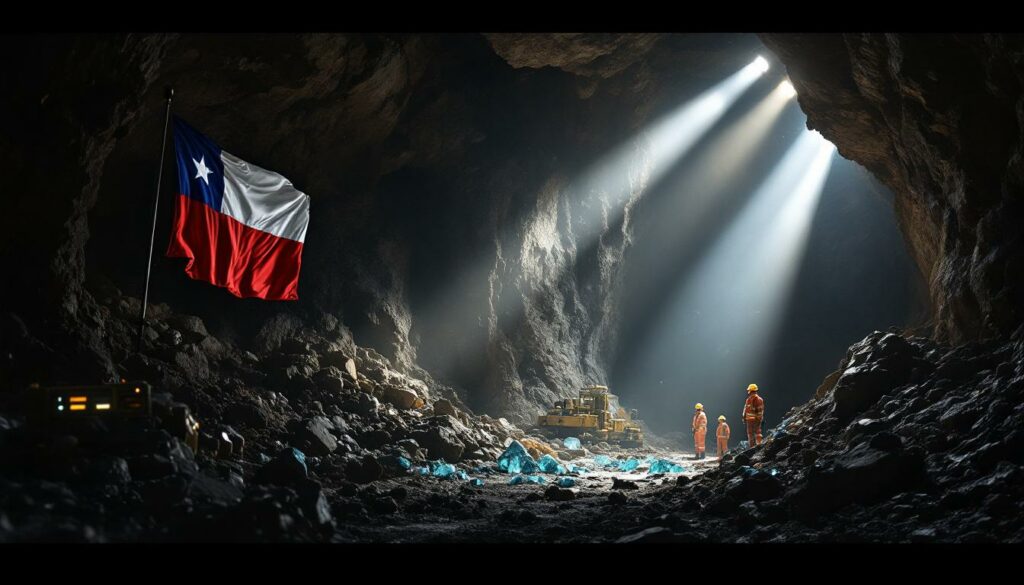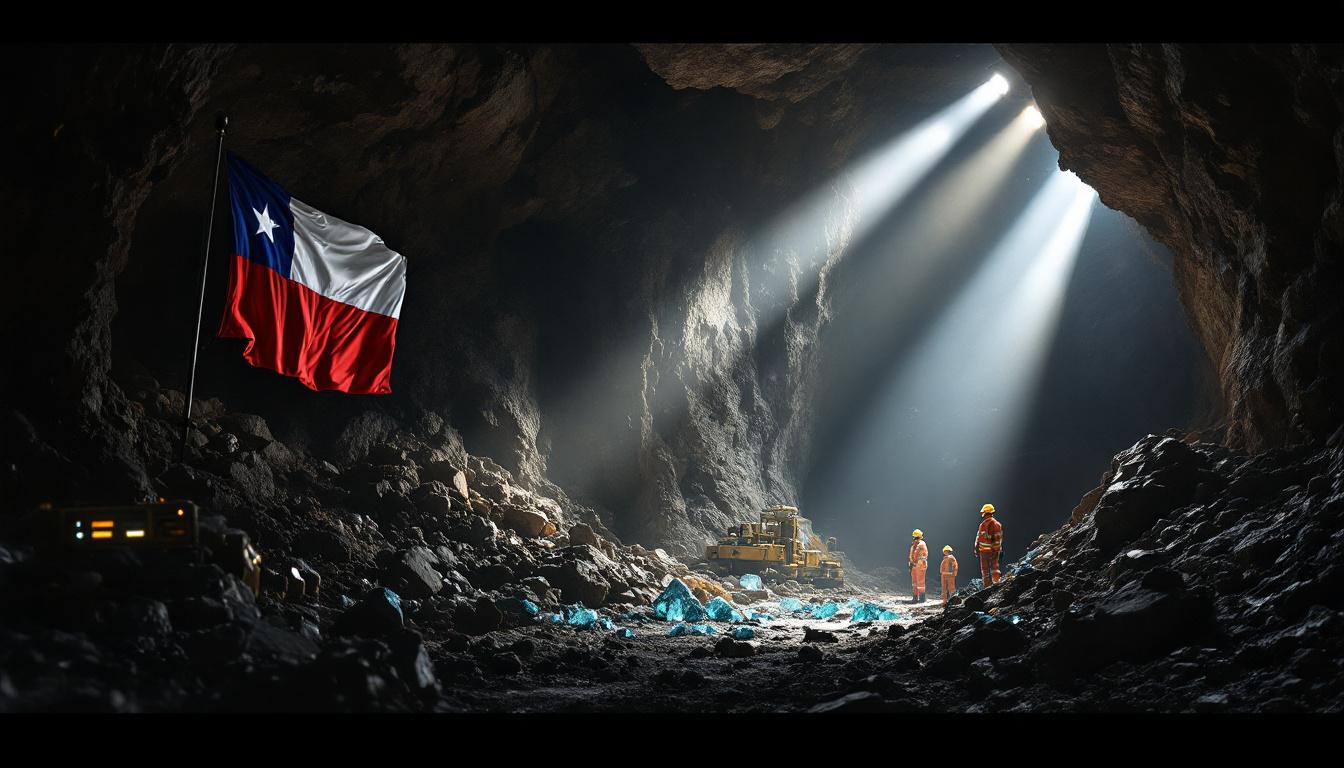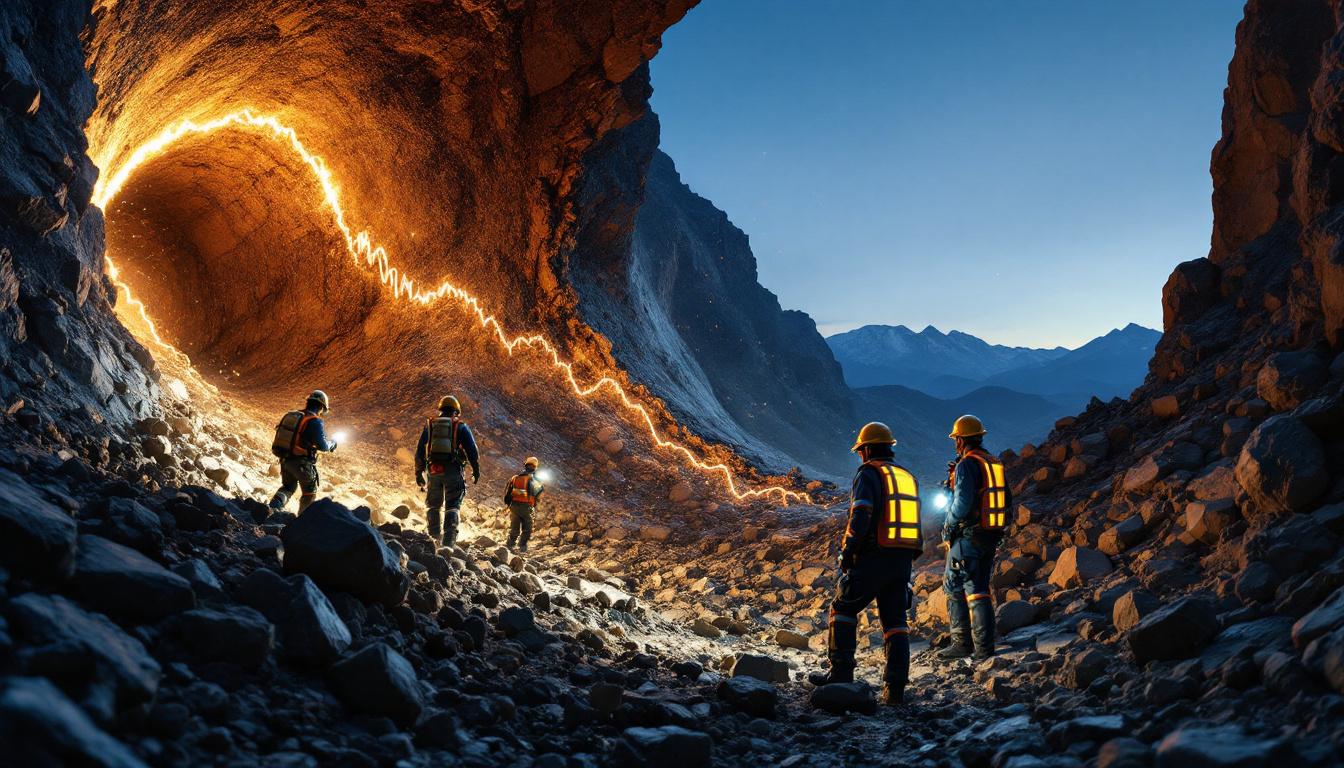What Happened at El Teniente? Understanding Codelco's Mining Collapse
On August 4, 2025, Codelco's El Teniente mine in Chile experienced a devastating collapse following seismic activity, resulting in six fatalities and prompting an immediate suspension of operations. This incident at the world's largest copper producer has sent ripples through the global copper market and raised serious questions about mining safety in seismically active regions. Recent copper price insights suggest this disruption could have significant market implications.
The El Teniente Incident: What We Know So Far
Timeline of the Collapse
The collapse at El Teniente was triggered by an earthquake that struck the region without warning. While specific magnitude details have not been officially released, the tremor caused significant structural failure in key underground sections of the mine. According to the initial Reuters report, six workers lost their lives in the incident, marking one of the most serious mining disasters in Chile in recent history.
The National Geology and Mining Service (SERNAGEOMIN) responded by immediately suspending all underground operations at the facility while emergency teams worked to secure affected areas and account for all personnel.
"The safety of our workers remains our absolute priority," stated Codelco in their initial press release following the incident. "We are committed to restoring operations as soon as safety conditions permit, but the effects of the stoppage cannot yet be estimated."
Search and rescue teams worked tirelessly in the hours following the collapse, navigating unstable tunnels and hazardous conditions. The challenging underground environment complicated rescue efforts, with rescue teams having to proceed with extreme caution due to the risk of secondary collapses.
Initial Response from Codelco and Authorities
Following the collapse, Codelco implemented their emergency response protocol, mobilizing specialized mine rescue teams and medical personnel to the site. The company established an emergency command center to coordinate rescue operations and communicate with families of affected workers.
SERNAGEOMIN, Chile's mining regulator, took swift action by ordering the immediate suspension of all underground mining activities at El Teniente. This regulatory body is now overseeing the investigation into the cause of the collapse and will determine when operations can safely resume.
The Chilean government has also dispatched mine safety specialists to assist with the investigation and ensure that proper procedures are followed during the recovery and analysis phase. Minister of Mining representatives have been on-site monitoring the situation and providing updates to the public.
What Reports Must Codelco Submit to Resume Operations?
Four Critical Reports Required by SERNAGEOMIN
Before Codelco can resume underground mining operations at El Teniente, SERNAGEOMIN has mandated the submission of four comprehensive technical reports, as detailed in a government document cited by Reuters:
-
Comprehensive Analysis of Collapse Causation: This report must identify all factors that contributed to the structural failure, including geological conditions, mining practices, and the impact of the seismic activity. It must provide a detailed scientific assessment of how these factors interacted to cause the collapse.
-
Detailed Recovery Plan: Codelco must outline specific steps, timelines, and methodologies for safely recovering affected areas. This plan needs to include engineering specifications for rebuilding damaged sections and protocols for ensuring worker safety during the recovery process.
-
Evaluation of Existing Fortification Systems: This critical assessment must analyze why current support structures failed during the seismic event. The report should identify weaknesses in the existing fortification systems and explain how these vulnerabilities contributed to the collapse.
-
Risk Assessment and Prevention Strategies: The final report must detail comprehensive measures to prevent similar incidents in the future, including enhanced monitoring systems, improved emergency response protocols, and updated safety training programs.
According to mining safety experts, these reports typically require extensive geological testing, structural engineering analysis, and consultation with international specialists—a process that could take several months to complete thoroughly.
Technical Requirements for Regulatory Approval
For SERNAGEOMIN to approve the resumption of operations, Codelco's reports must meet stringent technical standards. While the specific engineering requirements haven't been publicly detailed, industry standards for mines in seismic zones typically include:
- Advanced ground support systems capable of withstanding specified seismic loads
- Real-time microseismic monitoring networks with automatic alert systems
- Updated evacuation protocols with clearly defined trigger points
- Reinforced refuge chambers with extended life support capabilities
- Redundant communication systems that can function during emergencies
The review process typically involves multiple stages of technical assessment, site inspections, and possibly supervised testing of implemented safety measures. Given the seriousness of the incident, SERNAGEOMIN is expected to apply particularly rigorous standards before granting approval to restart operations.
How Will This Impact Copper Production and Markets?
Short-term Production Implications
El Teniente is a cornerstone of Codelco's production portfolio and a significant contributor to global copper supply outlook. While Codelco has not yet released specific production loss estimates, analysts suggest the suspension could impact thousands of tons of copper output depending on the duration of the shutdown.
Surface processing operations using previously extracted ore may continue in some capacity, which could temporarily mitigate some production losses. However, sustained underground mining suspension will inevitably affect Codelco's output targets for the year.
Industry observers note that Codelco may implement production increases at other facilities to offset some of the shortfall, though such measures have practical limitations and cannot fully compensate for El Teniente's suspended output.
Market Response to the Disruption
The copper market has shown immediate sensitivity to the El Teniente incident, reflecting the mine's importance in global supply chains. While specific price movements were not detailed in the source material, such disruptions typically trigger short-term price volatility as markets assess the potential supply constraints.
Major copper consumers, particularly in manufacturing and electronics sectors, may need to activate contingency supply arrangements if the suspension extends beyond a few weeks. Some buyers might accelerate purchases from alternative producers in Peru, Australia, or Indonesia to secure needed supply.
"Supply disruptions of this nature, particularly at a producer of Codelco's magnitude, typically create ripple effects throughout the copper value chain," notes a mining industry analyst. "The market's reaction will largely depend on the projected timeline for resuming operations."
Historically, similar disruptions have led to temporary price increases of 3-5% in copper markets, though current global inventory levels and rising copper demand will influence the actual impact of this specific event.
What Safety Measures Are Being Implemented?
Expert Panel Formation
According to Reuters, Codelco is "convening a panel of international experts to audit the El Teniente mine and establish what exactly happened." This independent technical review represents a critical step in understanding the failure mechanisms and developing appropriate remedial measures.
The expert panel will likely include specialists in:
- Mining geotechnical engineering
- Seismic risk assessment
- Underground structural engineering
- Mine safety systems design
- Emergency response planning
These specialists will conduct a comprehensive review of El Teniente's existing systems, comparing them against international best practices and identifying critical gaps that need addressing before operations can safely resume.
Enhanced Safety Protocols Under Consideration
While specific new safety protocols have not yet been publicly detailed, industry standards suggest Codelco will likely implement several advanced measures:
- Enhanced Seismic Monitoring: Installation of expanded microseismic monitoring networks capable of detecting precursor activity that might indicate increased collapse risk
- Dynamic Support Systems: Implementation of more robust ground support capable of absorbing energy from seismic events
- Advanced Warning Systems: Deployment of AI-driven predictive systems that can identify potential failure patterns before they become critical
- Refuge Chamber Upgrades: Enhancement of emergency shelters with extended life support capabilities and redundant communication systems
- Personnel Tracking: Implementation of real-time location systems to quickly account for all workers during emergencies
The company will also likely revise its training programs to ensure all personnel are thoroughly prepared for seismic emergencies, with regular drills and updated evacuation procedures.
How Does This Compare to Other Mining Disasters?
Historical Context of Mining Collapses
Chile has experienced several significant mining incidents throughout its history, most notably the 2010 Copiapó mining accident at the San José copper-gold mine, where 33 miners were trapped underground for 69 days before being rescued. While different in nature from the El Teniente collapse, this incident led to substantial improvements in Chilean mine safety regulations.
Underground mining in seismically active regions faces inherent challenges that have resulted in similar incidents globally. Notable examples include South Africa's deep gold mines, which regularly experience seismicity-induced collapses, and Peru's copper mines, which operate in comparable geological conditions.
Each major incident has contributed to the evolution of safety standards, with technological solutions and regulatory requirements developing in response to identified failure mechanisms.
Industry-Wide Safety Standards Evolution
The mining industry has progressively improved safety standards following major incidents, with particular attention to mines in seismically active regions. Key developments include:
- Dynamic Support Systems: Evolution from static support to energy-absorbing systems designed specifically for seismic conditions
- Real-time Monitoring: Advancement from periodic inspections to continuous, sensor-based monitoring of ground conditions
- Risk-Based Design: Shift from standardized support to site-specific designs based on detailed risk assessment
- Emergency Response: Development of sophisticated rescue capabilities and refuge systems specifically for underground mining emergencies
Codelco's response to this incident will likely establish new benchmarks for the industry, particularly regarding seismic risk management in large-scale underground mining operations.
What's Next for El Teniente and Codelco?
Reopening Timeline Projections
While Codelco has not yet provided official timeline estimates for resuming operations, industry precedents suggest several potential scenarios:
- Best-case scenario: Partial resumption of operations in unaffected areas within 1-2 months, following initial safety assessments and implementation of enhanced monitoring
- Moderate scenario: Phased restart over 3-6 months, with different sections resuming operations as specific safety improvements are completed and verified
- Extended scenario: Full resumption taking 6-12 months, requiring comprehensive rebuilding of affected areas and implementation of entirely new safety systems
The actual timeline will depend on the findings of the investigation, the extent of required remediation, and the stringency of SERNAGEOMIN's review process for the mandated reports.
Long-term Strategic Implications
This incident will likely have far-reaching implications for Codelco's operational strategy and financial outlook. Potential long-term impacts include:
- Production Forecasts: Revision of annual and multi-year production targets to account for both the immediate disruption and potentially reduced extraction rates under enhanced safety protocols
- Capital Expenditure: Significant unplanned investment in safety infrastructure and potentially accelerated development of alternative production areas
- Mining Methodology: Possible reconsideration of extraction methods in high-risk areas, potentially shifting toward more conservative but safer approaches
- Technology Investment: Accelerated adoption of advanced monitoring and automation technologies to reduce personnel exposure to high-risk environments
Codelco may also face increased scrutiny from investors, insurers, and lenders regarding its risk management practices across all operations, potentially affecting financing costs for future projects.
FAQ: El Teniente Mine Collapse
What caused the collapse at El Teniente?
The collapse was triggered by an earthquake that affected the mine's underground structures. The specific magnitude and epicenter details have not been officially released, though SERNAGEOMIN's investigation is expected to provide a comprehensive analysis of how seismic activity interacted with existing mining conditions to cause the failure.
Preliminary assessments suggest the collapse may have involved a combination of factors, including the seismic event, geological stress conditions, and potentially pre-existing vulnerabilities in support structures. The expert panel convened by Codelco will conduct a thorough investigation to identify all contributing factors.
How significant is El Teniente to global copper supply?
El Teniente is one of the world's largest underground copper mines and a cornerstone of Codelco's production portfolio. While specific production figures weren't provided in the source material, the mine is known to be a significant contributor to global copper supply.
The temporary suspension of underground operations will create ripple effects throughout supply chains, particularly if the shutdown extends beyond a few weeks. Major manufacturing sectors that rely heavily on copper, including electronics, construction, and renewable energy, may face supply challenges if alternative sources cannot compensate for the production shortfall.
What compensation measures exist for affected workers and families?
Chilean mining regulations mandate comprehensive compensation and support systems for workers affected by mining disasters and their families. While specific details of Codelco's response haven't been detailed in the provided sources, standard practice in the Chilean mining industry includes:
- Immediate financial support for families of deceased workers
- Continued salary payment for displaced workers during operational suspensions
- Psychological support services for affected workers and families
- Medical coverage for injuries sustained during the incident
- Long-term compensation packages for permanently disabled workers
Codelco likely has additional company-specific programs to support affected workers beyond the legally required minimum provisions.
How will this incident affect Codelco's future operations?
This incident will likely prompt a comprehensive review of safety practices across all Codelco operations, particularly those in seismically active zones. The company has stated it is "committed to restoring operations as soon as safety conditions permitted," indicating a focus on addressing root causes rather than rushing to resume production.
Long-term effects may include:
- Enhanced regulatory oversight of all Codelco operations
- Increased capital expenditure on safety systems across the company's portfolio
- More conservative mining approaches in high-risk areas
- Accelerated research into advanced monitoring and prediction technologies
- Potential organizational changes to strengthen safety governance
Expert Analysis: Mining Safety in Seismic Regions
Geological Challenges of Mining in Chile
Chile's position along the Pacific "Ring of Fire" creates unique challenges for mining operations. The region experiences frequent seismic activity due to the subduction of the Nazca Plate beneath the South American Plate, creating inherent risks for underground mining operations.
These geological conditions require specialized approaches to mine design and operation, including:
- Detailed seismic hazard assessment for all mine development plans
- Dynamic support systems designed specifically for seismic loading conditions
- Regular reassessment of ground conditions as mining progresses
- Sophisticated monitoring systems to detect precursor activity
- Strategic mine layout design to minimize vulnerability to seismic events
Mining engineers working in such environments must constantly balance production objectives with the realities of operating in a seismically active region, requiring specialized expertise not needed in more geologically stable mining regions.
Balancing Production and Safety
The El Teniente incident highlights the perpetual challenge of balancing production targets with safety considerations in high-risk mining environments. While modern mining industry evolution trends have implemented extensive safety measures, the economic pressures to maintain production can sometimes influence operational decisions.
Industry best practices emphasize several approaches to managing this balance:
- Safety-oriented key performance indicators with equal weight to production metrics
- Independent safety oversight with authority to halt operations when necessary
- Investment in technologies that improve both safety and productivity
- Regular third-party audits of safety systems and practices
- Transparent reporting of near-misses and safety incidents
As Codelco works to resume operations at El Teniente, the company faces the challenge of demonstrating a renewed commitment to safety while still meeting its obligations as a critical supplier to global copper markets. This will likely require substantial investment in modern mine planning technologies and methodologies.
Disclaimer
This article provides analysis based on currently available information. The situation at El Teniente is still developing, and details may change as Codelco's investigation proceeds and official reports are released. The economic and market impact assessments represent informed analysis rather than definitive predictions. Investors and industry participants should consult multiple sources when making decisions related to this event.
Want to Spot the Next Major Mineral Discovery Before the Market Does?
Discovery Alert's proprietary Discovery IQ model delivers real-time notifications when significant mineral discoveries are announced on the ASX, helping investors gain a crucial market advantage. Explore how historic discoveries have generated substantial returns by visiting the Discovery Alert discoveries page and position yourself to capitalise on the next major find.




